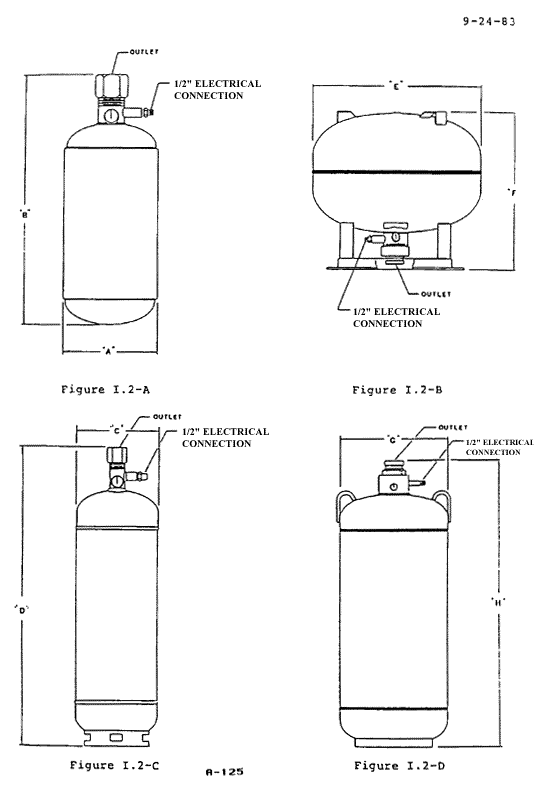
FIKE HALON 1301 SYSTEM CONTAINERS AND VALVES

U.L. EX2828
7/10/88
III.6 CONTAINER ELECTRICAL CONNECTIONS
Electrical conduit may be connected to the container in one of two ways (See Figure III.6)
Method # l is preferred for 125 lb. and 215 lb. spherical style containers so that the junction box is easily accessed. Method #2 is desirable for all other container styles because it simplifies maintenance and service functions when removing the initiator. Care should be taken when installing the junction boxes and conduit to insure that the retainer nut does not move on 1" and 2 1/2" style valves (See Figure6.)
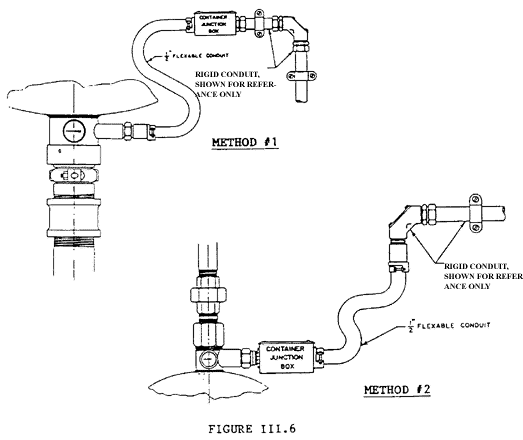
The container must have an agent release module, which is supplied. The agent release module is mounted in the container junction box by means of an adhesive strip located on the back of the module. Do not mount the A.R.M. to the junction box lid.
System wiring will vary from system to system and depending on the type of control system used. Consult system plans and the appropriate control manuals for specific system wiring information.
III.6.1 INITIATOR INSTALLATION
Read and understand this section before attempting to install initiators.
All system components must be installed, and the electrical and control systems thoroughly checked out by a factory trained technician as outlined in Section IV before proceeding with the initiator installation.
WARNING:
Initiators are small pyrotechnic devices that can cause bodily injury and equipment damage if improperly handled. Read and understand this entire section before installing initiators. Accidental activation will not occur when the procedures in this section are followed.
Initiators employed in the Fike System are widely used in industrial applications and must be respected for their extremely fast response and the possibility of accidental detonation. When initiators are handled properly, accidental detonation will not occur.
Safety procedures which should be observed when handling initiators are as follows:
After the electrical and control systems have been checked out, proceed with the initiator installation step by step as follows:
|
Step 1: |
Move the "armed/disabled" switch on the control panel to the "disabled" position. |
|
Step 2: |
Wait a minimum of 10 minutes to allow capacitors in initiator modules to dissipate their electrical charge. |
|
Step 3: |
Unwrap initiator leads and screw the threaded portion of the assembly into the retainer nut (or initiator boss on 3" valves) and tighten to approximately 40 inch pounds (See Figure III.6.1). |
|
Step 4: |
Pass leads through hole in electrical box or conduit if they were removed and reinstall. |
|
Step 5: |
With shunt intact, strip about 1/2" of insulation on each lead about 2 inches back from the shunt. |
|
Step 6: |
Insert stripped sections of initiator leads under center screw terminals (no polarity requirement) located on the agent release module and tighten screw terminals (See Figure III.1.10-B for pictorial clarification). |
|
Step 7: |
Repeat steps 3 thru 6 for all containers in the system. |
|
Step 8: |
Clip shunts off of all initiator leads and close all electrical boxes. |
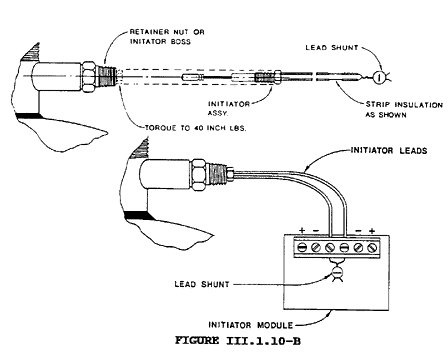
|
Step 9: |
Check control panel for any trouble indication other than the one caused by the "armed/disabled" switch being in the "disable" condition. |
|
Step 10: |
If no other trouble conditions exist, move the "armed/disabled" switch to the "armed" position and reset the control panel. |
The Containers Are Now Armed!
WARNING:
Do not "ARM" the system if a ground fault indication is present.
Every three months:
Check the pressure gauge of each container. If the pressure is less than 350 PSIG at 70ºF, the container should be removed, weighed, and recharged as necessary. The container pressure will vary directly with temperature. In the range of 55º F to 85º F this change is approximately 3 PSI per degree. Refer to Table V.3 "Container Pressure versus Temperature."
|
TEMP |
º F |
-40 |
-30 |
-20 |
-10- |
0 |
10 |
|
º C |
-40 |
-38.4 |
-28.9 |
-23.3 |
-17.8 |
-12.2 | |
|
NOMINAL PRESSURE PSIG |
136 |
149 |
163 |
178 |
194 |
212 | |
|
TEMP |
º F |
20 |
30 |
40 |
50 |
60 |
70 |
|
º C |
-6.7 |
-1.1 |
4.4 |
10.0 |
15.6 |
21.1 | |
|
NOMINAL PRESSURE PSIG |
232 |
253 |
276 |
302 |
330 |
360 | |
|
TEMP |
º F |
80 |
90 |
100 |
110 |
120 |
130 |
|
º C |
26.7 |
32.2 |
37.8 |
43.3 |
48.9 |
54.4 | |
|
NOMINAL PRESSURE PSIG |
393 |
430 |
470 |
513 |
560 |
612 | |
TABLE V.3
Every six months:
The containers should be removed and weighed to verify the correct Halon 1301 weight stamped on the label. If the weight shortage is greater than 5% of the correct weight the container must be recharged.
NOTE:
If the container has a liquid level indicator installed, this verification can be made without the need for cylinder removal.
When removing the container for weighing, the control system must be in the "disabled" position and the initiators shunted and removed.
Reinstall the containers and initiators according to the Procedures in the system installation section of this manual.
V.3.1. VALVE RECONDITIONING
After the container has been discharged, the valve will need to be reconditioned using the appropriate reload kit.
If the container was not discharged, and a leaky valve needs to be reconditioned, the contents of the container should be emptied or transferred to another container before reconditioning the valve.
WARNING:
Container contents are under high pressure, therefore, never attempt to rebuild the valve until the contents are emptied and the pressure gauge reads 0 PSIG.
Care should be taken when handling valve components to avoid damage of any kind. Be careful not to bend, poke, or otherwise distort the valve rupture discs as their service may adversely be affected.
V.3.1.1 1" IN VALVE (5 lb., 10 lb., 20 lb., 35 lb., 60 lb., and 100 lb. containers)
To recondition the 1" valve refer to Figure V.3.1.1 for pictorial clarification and identification of valve parts and the following steps:
|
Step 1: |
Remove the 1 inch adapter nut. |
|
Step 2: |
Remove the 1 inch outlet assembly and "O" ring. |
|
|
(Note: This part may be returned for credit.) |
|
Step 3: |
Remove the retainer nut. |
|
Step 4: |
Remove the detonator housing assembly and teflon washer.(Note: This part may be returned for credit, discard teflon washer.) |
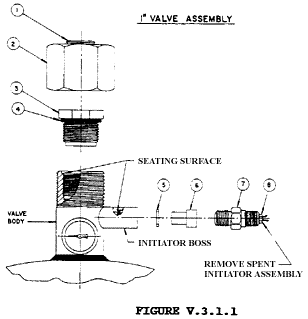
|
ITEM NO |
DESCRIPTION |
REPLACEMENT PART |
|
1 |
BAFFLE PLUG |
|
|
2 |
ADAPTER NUT |
|
|
3 |
OUTLET ASSEMBLY |
X |
|
4 |
"O" RING |
X |
|
5 |
TEFLON WASHER |
X |
|
6 |
DETONATOR HOUSING ASSEMBLY |
X |
|
7 |
RETAINER NUT |
|
|
8 |
INITIATOR ASSEMBLY (70-1058) |
X |
|
Step 5: |
Clean all debris from teflon washer and "O" ring seating surfaces with fine emery cloth. Surfaces must be dirt and rust free. Clean all threads and blow out all valve areas with an air gun. |
|
Step 6: |
Place new teflon washer on new detonator housing assembly and reinstall in valve initiator boss. |
|
Step 7: |
Reinstall retainer nut and torque to 90-150 inch pounds. Do Not Over tighten! |
|
Step 8: |
Apply a light film of Dow Corning silicone sealer (or equal) to "O" - ring seating surface. |
|
Step 9: |
Install new "O"-ring on outlet assembly. Install outlet assembly and tighten until assembly bottoms out. |
|
Step 10: |
Remove and replace valve core in the brass fill valve located on the side of the discharge valve. |
|
Step 11: |
Reinstall the adapter nut and baffle plug. |
The container is now ready for recharging.
V.3.2.2 2 1/2" VALVE (70-041, 125 lb., and 70-077, 215 lb. containers)
To recondition the 2 1/2" valve, refer to Figure V.3.1.2 for pictorial clarification and identification of valve parts and the following steps:
|
Step 1: |
Remove grooved coupling and baffle plate from valve outlet. |
|
Step 2: |
Remove holddown nut using left-hand spanner wrench (available from Fike). |
|
Step 3: |
Remove holddown ring, "O"-ring, and rupture disc. Discard rupture disc and "O"-ring. |
|
Step 4: |
Remove detonator housing and teflon washer. Discard washer. (Note: Detonator housing may be returned for credit). |
|
Step 5: |
Clean all debris from teflon washer and "O"-ring seating surfaces with fine emery cloth. Surfaces must be dirt and rust free. Clean all threads and blow out all valve areas with an air gun. |
|
Step 6: |
Place new teflon washer on new detonator housing assembly and reinstall in valve initiator boss. |
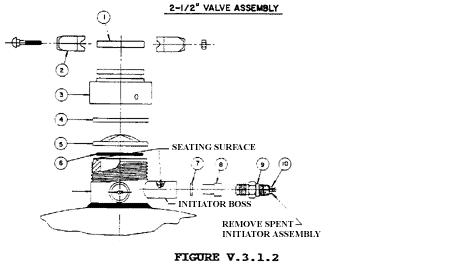
|
ITEM NO |
DESCRIPTION |
REPLACEMENT PART |
|
1 |
BAFFLE PLATE |
|
|
2 |
VICTAULIC COUPLING |
|
|
3 |
HOLDDOWN NUT |
|
|
4 |
HOLDDOWN RING |
|
|
5 |
RUPTURE DISC |
X |
|
6 |
"O" RING |
X |
|
7 |
TEFLON WASHER |
X |
|
8 |
DETONATOR HOUSING ASSEMBLY |
X |
|
9 |
RETAINER NUT |
|
|
10 |
INITIATOR ASSEMBLY (70-1058) |
X |
|
Step 7: |
Reinstall retainer nut and torque to 90 - 150 inch pounds. Do not over tighten! |
|
Step 8: |
Apply a thin film of Dow Corning silicone vacuum grease (or equal) to "O"-ring groove and place new "O"-ring into groove. |
|
Step 9: |
Install new rupture disc, convex side up, and place holddown ring centered over rupture disc. |
|
Step 10: |
Reinstall holddown nut and torque to 60 foot pounds or use the following method: Spin holddown nut on by hand and tighten hand tight. Further tighten with right hand spanner wrench 1/3 turn minimum. (Wrench available through Fike). |
|
Step 11: |
Remove and replace valve core in the brass fill valve located on the side of the discharge valve. |
|
Step 12: |
Reinstall the grooved coupling and baffle plate. |
The container is now ready for recharging.
V.3.1.3 3" VALVE (70-087, 215 lb., 375 lb., 650 lb., and 1000lb. Containers)
To recondition the 3" valve, refer to Figure V.3.1.3 for pictorial clarification and identification of valve parts and the following steps:
|
Step 1: |
Remove grooved coupling and baffle plate. |
|
Step 2: |
Remove holddown nut using a left or right handed spanner wrench (available through Fike). |
|
Step 3: |
Remove the valve assembly containing the two rupture discs. |
|
Step 4: |
Remove siphon tube assembly and "O"-rings. |
|
Step 5: |
Clean all debris from "O"-ring grooves and flat seating surface in bottom of valve body using fine emery cloth. Surface must be dirt and rust free. Clean all threads and blow out all valve areas with an air gun. |
|
Step 6: |
Apply a thin coating of Dow Corning silicone vacuum grease (or equal) to "O"-ring grooves and flat seating surface in valve body. |
|
Step 7: |
Place new "O"-rings in grooves and reinstall siphon tube assembly making sure it rests squarely on the flat seating surface. |
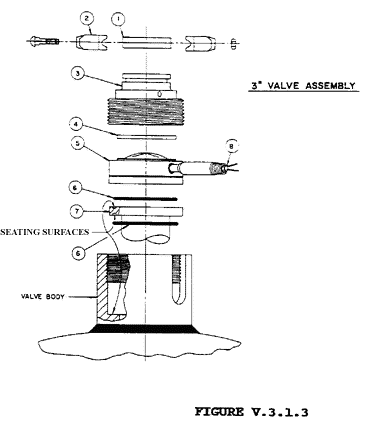
|
ITEM NO |
DESCRIPTION |
REPLACEMENT PART |
|
1 |
BAFFLE PLATE |
|
|
2 |
VICTAULIC COUPLING |
|
|
3 |
HOLDDOWN NUT |
|
|
4 |
HOLDDOWN RING |
|
|
5 |
VALVE ASSEMBLY |
X |
|
6 |
"O" RING |
X |
|
7 |
SIPHON TUE ASSEMBLY |
|
|
8 |
INITIATOR ASSEMBLY (70-1336) |
X |
|
Step 8: |
Apply a thin coating of Dow Corning Silicone Vacuum grease (or equal) to top "O"-ring and siphon tube assembly. |
|
Step 9: |
Install new valve assembly with bulged rupture disc pointing up. Initiator boss on valve assembly must point through slot on valve body. |
|
Step 10: |
Center holddown ring on top of the rupture disc on valve assembly. Spin holddown nut on until hand tight. Tighten nut with left or right hand spanner wrench until nut no longer turns. |
|
Step 11: |
Remove and replace valve core in brass fill valve located on the side of the discharge valve. |
|
Step 12: |
Reinstall the grooved coupling and baffle plate |
The container is now ready for recharge.
V. 4 INITIATORS
WARNING:
Initiators are small pyrotechnic devices that can cause bodily injury and equipment damage if improperly handled. Refer to Section III.6.1 for proper handling of initiators.
Before checking or servicing initiators, move the "armed/disabled" switch on the system control panel to the "disabled" position. Allow ten minutes for the capacitors the initiator modules to dissipate their charge.
Every six months:
Check initiator leads and wiring to initiator modules for corrosion. Also, check for loose or broken wires.
Every Five Years:
Replace initiators. Refer to Section III.6.1 for initiator installation.
V.5 CONTAINER TEST AND INSPECTION
Halon 1301 containers shall not be recharged without a retest if more than five years have elapsed since the last test. The retest consists of a complete external and internal visual inspection in accordance with the Code of Federal Regulations, Title 49, Section 173.34(e)(10). The C.F.R. requirements also refer you to the Compressed Gas Association Pamphlet C-6, Section 3.
Cylinders continuously in service without discharging shall be given a complete external visual inspection every five years. The cylinder does not need to be emptied for this inspection.
All visual inspections must be performed according to the regulations of C.F.R. Title 49, and C.G.A. Pamphlet C-6, Section 3. All inspections are to be done by C.G.A./D.O.T. approved inspectors only.
GINGE KERR
HALON 1301
SYSTEM VALVES
|
Release panel 5444 |
P32 | |
|
GINGE |
MALSKITSE |
Type 06-6441-00 |
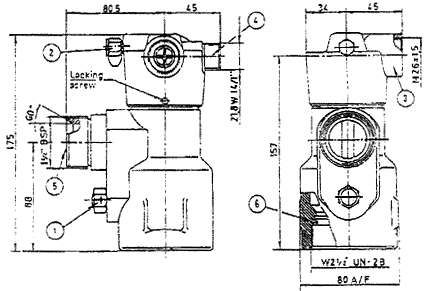
Working pressure: 100 bar
pressure: 150 bar
Weight: 3.7 kg
Material:
Brass
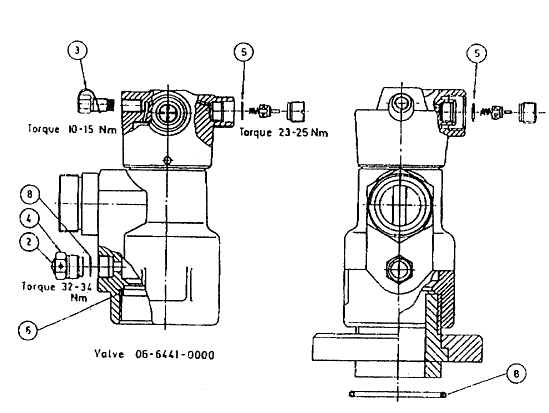
GINGE FIRE EXTINGUISHING SYSTEMS
KERR: MADE BY DATE: BV
1985-09- 03
APP BY /DATE: POJ 1985-09-03
DATE OF ISSUE"
1985-09-03
REV: C
CODE NO 06-6441-0000
Pneumatic Halon Valve.
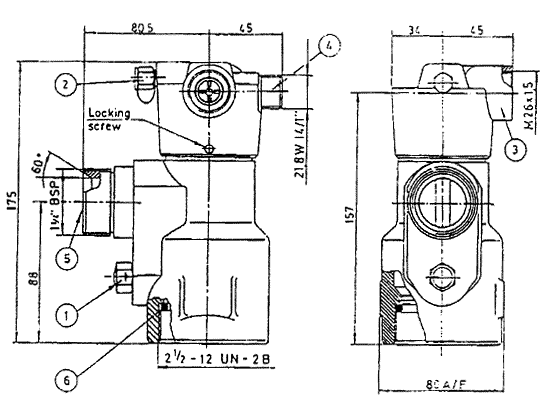
Valve for H1301 High Pressure Cylinder.
The Valve is pneumatically operated by the Actuator.
Pressure for activation: 10 bar at cylinder pressure of 100 bar.
Material: Mainly Brass.
Working Pressure: 100 bar.
Test Pressure: 150
bar.
Weight: 3.7 kg
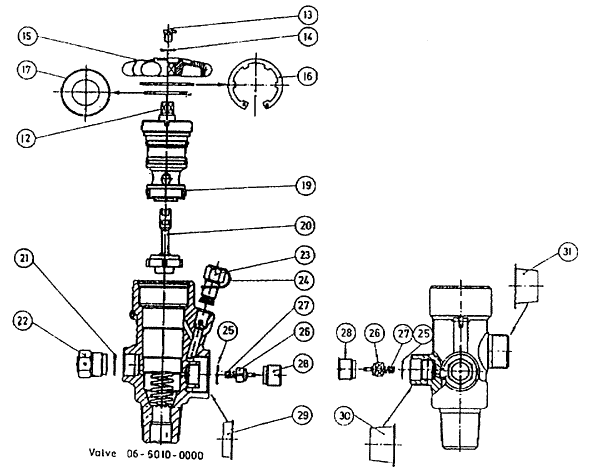
GINGE FIRE EXTINGUISHING SYSTEMS
KERR: MADE BY DATE: BV
1985-09- 03
APP BY /DATE: POJ 1985-09-03
DATE OF ISSUE"
1985-09-03
REV: C
CODE NO 06-6441-0000
Pneumatic Halon Valve.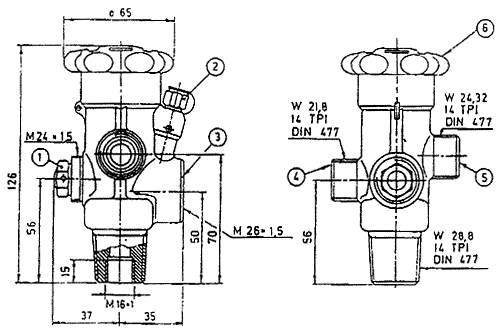
Valve for H1301 High Pressure Cylinder.
The Valve is pneumatically operated by the Actuator.
Pressure for activation: 10 bar at cylinder pressure of 100 bar.
Material: Mainly Brass.
Working Pressure: 150 bar.
Test Pressure: 250
bar.
Weight: 1.2 kg
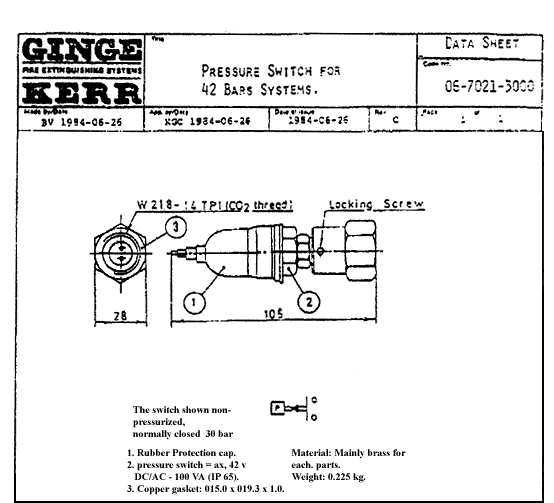
|
Authorization Course Release panel 5444 |
P32 | ||
|
GINGE |
Type 06-95 2526-00 | ||
|
Cylinder: Material: Steel, Painted red |
| Type | Liter | Liter | empty kg | filling Kg | A | B |
| 06-9525 | 45, 0 | 51, 0 | 29 | 50 | 1108 | 1200 |
| 06-9525 | 67, 75 | 82, 6 | 43 | 75 | 1543 | 1625 |
Dimensional Sketch Halon 1301 Cylinder 67, 5 L with Valve type 06-95(25)(26)-00
EDITION - M03
PYROTRONICS SERIES H
HALON 1301 SYSTEM CONTAINERS AND
VALVES
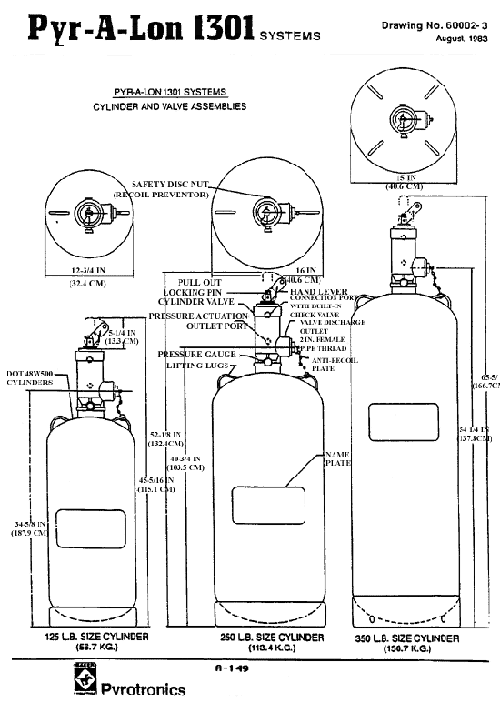
INTRODUCTION
Pyr-A-Lon 1301 Engineered Systems are custom engineered fire suppression systems designed in accordance with NFP 12A. Pyr-A-Lon 1301 Engineered Systems are listed by Underwriters Laboratories, Inc. and Underwriters Laboratories of Canada, and are approved by Factory Mutual Research Corporation. The instructions in this manual comply with the limitations and requirements established by those listings and approvals.
The extinguishing agent used in Pyr-A-Lon 1301 Engineered Systems is Halon 1301. Exactly how Halon 1301 extinguishes fire is not known: it has been termed a "chain breaking agent," meaning that it acts to break the chain reaction of the combustion process. Halon 1301 is chemically known as CBrF3 (bromotrifluoromethane); it is super-pressurized with dry nitrogen to 360 psig to provide rapid discharge and mixing.
The National Fire Protection Association has established a concentration of 5 percent Halon in air as being sufficient for most flame extinguishment. Refer to the SYSTEM DESIGN section (page 14) and NFPA 12A for a thorough explanation of concentration requirements for various hazards. In accordance with NFPA 12A, paragraphs 2-1.1.3 and 2-1.1.4. the following restrictions on concentrations must be followed.
|
Concentration |
Restrictions |
|
4-7% |
No restrictions on use |
|
Between 7% |
Can be used in unoccupied areas or in normally occupied areas where evacuation can be accomplished within 1 minute. Areas with a 10% concentration should be evacuated immediately upon discharge of agent. |
|
Between 10% |
Not to be used in normally occupied areas. |
|
More than 15% |
Provisions must be made to prevent in-halation by personnel. |
CAUTION: Halon 1301 is not effective on the following materials:
Although Halon 1301 vapor has a low toxicity, its decomposition products can be hazardous. Decomposition takes Place on exposure to flame or hot surfaces at about 900ºF. The main decomposition products are hydrogen fluoride (HF), hydrogen bromide (HBr), bromine (Br2), and small amounts of carbonyl fluoride (COF2) and carbonyl bromide (COB2).
The amount of Halon 1301 that will decompose while extinguishing a fire depends on the size of the fire, the concentration of Halon vapor, and the length of time Halon vapor is in contact with the flame or with heated surfaces. With small fires and rapid extinguishment. there is little decomposition: with large fires or slow extinguishment. there is a lot of decomposition. Rapid detection and immediate discharge at a high rate are therefore desirable so as to keep decomposition products at a minimum level. For further information on the toxicity of Halon 1301, and its decomposition produces. see Appendix A, 1-6.1, of NFPA Standard No. 12A.
SYSTEM COMPONENTS
Pyr-A-Lon 1301 Engineered Systems can be supplied with 15, 30, 60, 125, 250, 350, and 600 pound cylinders that are pressurized with dry nitrogen, at 70ºF, to 360 psi.
The cylinders are charged as follows:
|
Cylinder |
Fill increment |
Total Fill Weights |
|
8 pound |
1 pound |
4-8 pounds(FM sets minimum fill at 5 pounds) |
|
15 pound |
1 pound |
9-15 pounds |
|
30 pound |
5 pounds |
20-30 pounds |
|
60 pound |
5 pounds |
35-60 pounds |
|
125 pound |
5 pounds |
65-125 pounds (FM sets minimum fill at 75 pounds) |
|
250 pound |
5 pounds |
130-250 pounds(FM sets minimum fill at 150 pounds) |
|
350 pound |
5 pounds |
255-350 pounds |
|
600 pound |
5 pounds |
355-615 pounds |
A Pyr-A-Lon 1301 Engineered System consists of a cylinder assembly, valve assembly, and whatever hardware is shown in Figure 1 necessary for that particular system. The operation temperature range of all hardware in a Pyr-A-Lon 1301 Engineered System is - 40ºF to 130ºF.
CYLINDER AND VALVE ASSEMBLIES
The dimensions of all eight cylinder and valve assemblies are shown in Figure 1. All cylinders are manufactured, tested. And marked in accordance with Title 49 of the Code of Federal Regulations.*
Three valve sizes are used: 1 inch, 2 inch, and 3 inch (See Figure 2, page 3). The 1 inch valve is used on the 8, 15, 30, and 60 pound cylinders: the 2 inch valve is used on the 125, 250, and 350 pound cylinders; the 3 inch valve is used on the 600 pound cylinder. The valves are of high-flow-rate design to provide the rapid discharge required by NFPA 12A.
The 1, 2, and 3 inch valves are pressure-seated types that have a brass body, a brass piston with an elastomer seal. Pressure-releasing pilot check assembly for manual and/or pneumatic actuation. a burst disc assembly (1 and 2 inch sizes). and a pressure gauge. The valves can be fitted with an electric solenoid valve for electric actuation.
Actuation of the pilot check or electric solenoid relieves the pressure above the piston and allows the piston to travel upward in the bore of the valve. This action fully opens the valve, permitting Halon to discharge through the outlet.
MANIFOLD
The system manifold is considered part of the discharge piping and is covered in the SYSTEM INSTALLATION section (page 39) of this manual. In all systems using selector valves, the manifold must be fitted with a manifold safety that is comprised of a body with 3/4 inch male pipe thread, a safety disc. washer. and safety disc nut. Should liquid Halon be trapped in the manifold, it will be released before excessive pressure develops due to high temperatures.
* Title pertains to DOT-4BW-500 and 4BA-500 cylinder specifications.

3 INCH VALVE
FIGURE 2
CYLINDER VALVES - 1, 2, AND 3 INCH
SIPHON TUBE
All 8, 15, 30, and 60 pound cylinders are fitted with a siphon tube having a curved lower end that permits the cylinders to be mounted vertically (upright) or at any angle between vertical and horizontal. The current production of 125 and 250 pound cylinders. which have the letter H under the discharge outlet. are also fitted with curved siphon tubes that permit them to be mounted vertically or at any angle between vertical and horizontal. Earlier produced 125 and 250 pound capacity cylinders, without the identifying H on the valve, have curved siphon tubes of different shapes which affect the discharge characteristics to the extent that the cylinders cannot be mounted at an angle less than 10 degrees from a horizontal position.
The inlet of the siphon tube is installed in the cylinder valve in line with the valve safety disc nut. The cylinder, when mounted horizontally or at an angle, must always be installed with the safety disc nut down. so that the valve outlet is in a horizontal position. (Refer to the SYSTEM INSTALLATION section, page 39. of the manual for details.)
The 350 and 600 pound cylinders are fitted with straight siphon tubes. They must only be mounted vertically.
CYLINDER BRACKETS
Vertical, angle, or horizontal mountings of one basic group of bracketing parts used in selective combinations. Refer to the SYSTEM INSTALLATION section (page 39) for details. A special mounting assembly for the 125 and 250 cylinder assemblies that bear the H identification is used for a horizontal installation. There is also an earlier version of a horizontal mounting assembly that is used for cylinder assemblies with the old type siphon tube. When the 125, 250, 350, and 600 pound cylinders are mounted in an upright position, a wall mounting bracket is used. It consists of a mounting channel and a cylinder strap.
CYLINDER ACTUATING CONTROLS (See Figure 3)
There are five types of controls used for actuating valves of Pyr-A-Lon cylinders: 1) electric solenoid, 2) local manual mechanical control, 3) remote manual mechanical control, 4) pneumatic control, and 5) manual-pneumatic combination control (See Figure 3). For Pyr-A-Lon system with more than one cylinder, these controls need only be located on one cylinder. The cylinder with the controls is designated the master cylinder. Any additional cylinders in the system may be operated as slave cylinders by using actuators powered by the pneumatic actuation outlet port of the master cylinder.
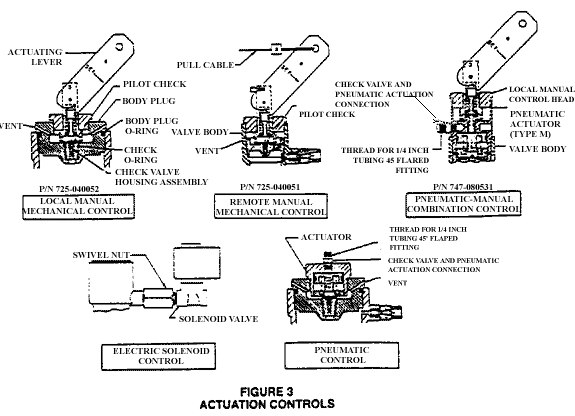
Electric Solenoid
The solenoid valve is normally closed. When electrical energy is applied to the solenoid valve. It opens. This relieves the pressure above the cylinder valve piston and opens the cylinder valve.
The solenoid valve is equipped with 24 inch wire leads that are connected to a junction box near the valve. A typical cylinder valve with a solenoid actuator valve is shown in Figure 4. The solenoid valve is fitted with a swivel nut that allows field installation or removal of the solenoid from a 1 or 2 inch valve. Figure 5 shows the solenoid valve assembly with a knurled adapter for use with the 3 inch cylinder valve. Removal of the solenoid valve assembly is often required during recharging or servicing of the cylinder. Solenoid valves are available with 6 VDC, 24 VDC, and 120 VAC coils in explosion-proof housings for Class 1 and 2 locations.
The entire control circuit and the solenoid coils are under constant supervision. Any break in the circuit will result in a trouble signal at the control panel. The panel can be arranged to operate upon actuation of any of the following types of detectors that are compatible and UL listed or FM approved.
|
Fixed Temperature Thermals |
Rate Compensated Thermals |
|
Rate of Rise Thermals |
Infrared Detectors |
|
Ionization Smoke Detectors |
Ultraviolet Detectors |
|
Photoelectric Smoke Detectors |
Manual Electric Stations |
|
Or, any combination of the above | |
Pyrotronics recommends that actuation of a Pyr-A-Lon system be made by detection, involving two detectors or two zones of detectors (cross zoning). This prevents the system from being actuated by a transient condition that causes only one detector to operate. Other types of alarm panels can be used to actuate the system if they are UL listed or FM approved for that purpose and are electrically compatible. Consult Pyrotronics for information on detection systems which can be used with Halon extinguishing systems.
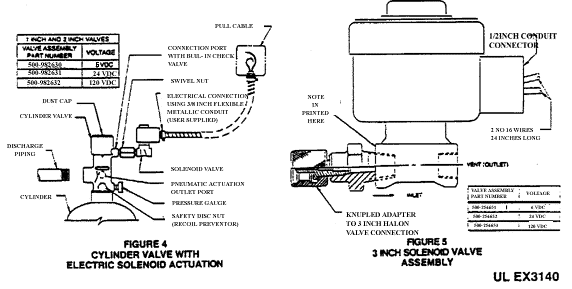
|
1 INCH AND 2 INCH VALVES |
VALVE ASSEMBLY |
VOLTAGE | |
|
VALVE ASSEMBLY |
VOLTAGE |
500-256651 |
6 VDC |
|
500-982630 |
6 VDC |
500-256652 |
24 VDC |
|
500-982631 |
24 VDC |
500-256653 |
120 VDC |
|
500-982632 |
120 VDC |
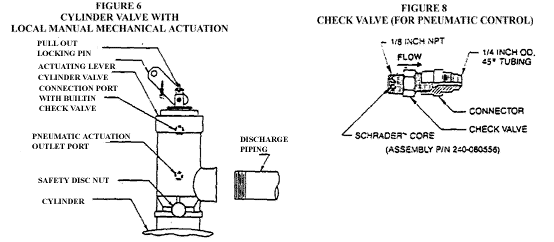
Note: For FM approval, any electric solenoid control system must also have manual mechanical control.
Local Manual Mechanical Control (P/N 725-040052)
The local manual mechanical control (or actuator) is threaded into the top of the cylinder valve. The valve is actuated by moving the actuating lever of the mechanical control through 90º. The movement causes the actuation pin to depress. That opens the pilot check on the cylinder valve. The open pilot check. in turn. releases the pressure above the piston, allowing the cylinder valve to open fully. See Figures 3 (page 4) and 6. Manually operated selector valves are controlled locally by moving the ball valve handle through 90º.
Remote Manual Mechanical Control (P/N 725-040051)
This control actuates in the same manner as the local mechanical manual control, except that the lever is controlled remotely by a 1/16-inchein-diameter stainless steel pull cable enclosed in a half-inch EMT. with comer pulleys at each change-in-direction location. The cable terminates in a remotely located pullbox. See Figures 3 (page 4) and 7.
Pneumatic Control (P/N 725-040045)
A pressure actuator pneumatic control can replace the manual control on a cylinder valve. The control contains a piston large enough to provide the necessary force to open the pilot check when the Halon discharge pressure from a master cylinder or from another source is applied. This pressure is routed through 1/4 inch tubing, 1/4 inch pipe, or 1/8 inch pipe connected to a 1/8 inch check valve that is fitted into the master cylinder valve pressure actuation outlet port. See Figures 8 and 48 (page 49). The Pressure actuator can operate the slave cylinders through the master cylinder pneumatic actuation outlet port. A maximum of ten pressure actuators for slave cylinders can be used with each master cylinder. See also the SYSTEM INSTALLATION section (page 39) and Figures 3 (page 4), 9. and 48 (page 49).
Pneumatic-Manual Combination Control (P/N 747-080531)
A special pressure actuator (Type M) can be used to have a pneumatic control and also either a local or a remote manual mechanical control on a cylinder valve. See Figures 3 (page 4) and 10.
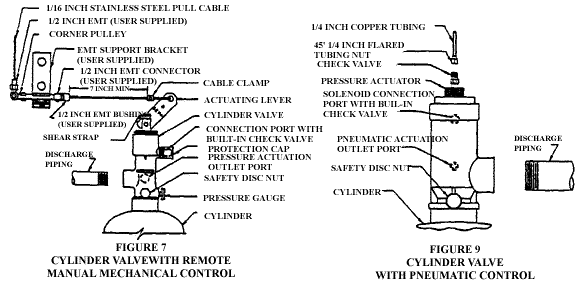
NOZZLES
Three basic Type E nozzle sizes are available for use with Pyr-A-Lon 1301 Engineered Halon Systems - 3/8 inch, 1 inch, and 1 ½ inch sizes. Each basic size can be supplied as a 180º or 360º nozzle. See Figure 11. The nozzles are custom drilled to provide the amount of Halon flow needed according to the piping system and nozzle flow rate calculations. Nozzle usage and limitations are described in the SYSTEM DESIGN section (page 14) and the SYSTEM INSTALLATION section (page 39) of this manual.
The 3/8 inch size nozzles are also available as duct nozzles (Type D): they are used for installations in ducts or in cabinets. They are identical to the 3/8 inch standard nozzles (Type E) except for a straight pipe thread machined on the neck of the nozzles. A standard set of 3/4 inch conduit locknuts are fitted to the thread for locking the nozzles to the sheet metal duct or cabinet See Figure 12 (page7). All nozzle sizes are available in brass.
MANIFOLD CHECK VALVES
Pyr-A-Lon 1301 System check valves utilize a poppet design that minimizes flow restriction of the system manifold. The valves are manufactured entirely of stainless steel. See the SYSTEM INSTALLATION section (page 39). These check valves are available in 1, 2, and 3 inch sizes; see Figure 13 (page 7).
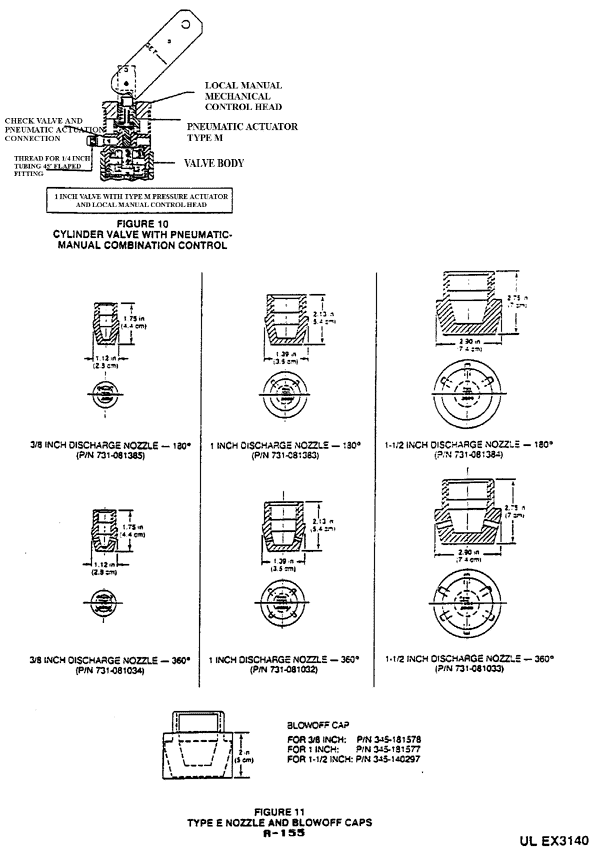
WORMALD
INTERNATIONAL
ELECTRIC VALVE ACTUATOR
|
SA. ANSUL N.V. |
|
|
|
PART OF INTERNATIONAL GROUP |
ELECTRIC VALVE ACTUATOR EVA |
MFG DATA SHEET: T46 DATE:09/86 RE: |
SCOPE:
The EVA actuator has been specially designed to be mounted on all the ANSUL
Halon and european carbon dioxyde valves of the latest generation by means of a
swivel nut.
The coupling allows ease of connection, positioning and removal
for testing or servicing.
This electric actuator may be used in combination with the multiple stock actuator (p/n 303444) offering pneumatic and manual actuation as well.
The actuator develops a very high actuation force, giving the possibility to operate either the halon valves types 360 psi US bar) and 600 psi (41,5bar) either the CO2 MA valves, from -20 degrees C up to +50 degrees C.
The connection and the disconnection of the plug-in connector provide the facility to remove the electric cable before disassembling the actuator from the valve. This is an appreciable advantage for inspection or arming in case of functional test and/or trouble shooting of the release circuit.
The connector is provided with & voltage peak suppression diode.
All materials in contact with the surrounding are in brass and zincolated bichromatod steel to provide a good corrosion resistance.
303426 Electric valve actuator - packed (fig 1) (with connector)
303445 Arming tool (fig 2)
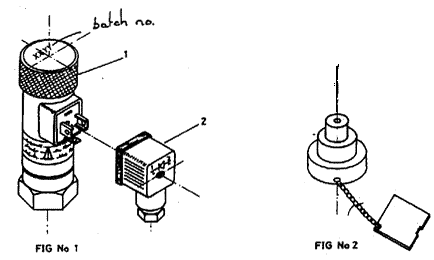
SEPARATE COMPONENTS
|
Fig No 1 |
Part No |
Description |
|
-- 1 2 |
303426 -- 801216 |
Electric valve actuator EVA - packed 303426 without connector Connector |
|
Fig No 2 |
Part No |
Description |
|
- |
303445 |
Arming tool - packed |
DIMENSIONS AND CONNECTION DATA
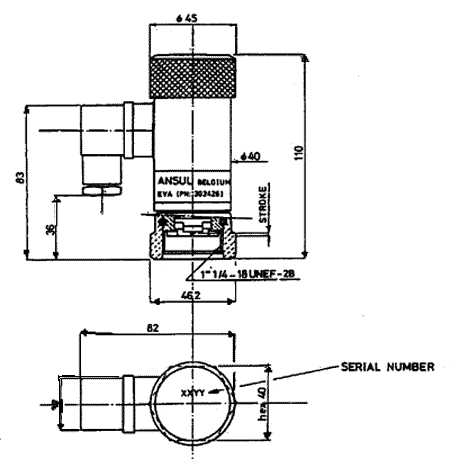
MATERIAL:
- Body: brass
-Coupling nut: brass
- Armature: mild steel (zincplated and bichromated)
- Connector: plastic
DATA DESIGN
-solenoid data:
- operating wattage: 24 VDC (+/- 6V)
- current: 100 mA(min)
- resistance: 180 Ohm (135 mA at nominal 24 VDC)
- temperature range:
- installed: -20 degrees C to +50 degrees C
- stored -30 degrees C to +75 degrees C
- functional data:
- potential energy stared: 2 joules
- minimum pull-in wattage: 18 VDC
- minimum drop out voltage after release, the spring pushes permanently on the piston with sufficient force to maintain the schrader valve open
- min. voltage application time : 1 sec.
- max. recommended voltage application time: 1 min. (e.g. during tests)
- plug-in connection date:
- cable gland : PG 11
- terminals: capability : 1, 5mm2 flexible wire
- terminate: 3 plugs No 1 = positive
No 2= negative
![]() =
earth
=
earth
- projection: by suppression diode 1N4007
- tightening grade: IP65
VALVE COMPATIBILITIES
The EVA actuator is designed for mounting on the following valves:
|
Halon:360 psi (25 bar) |
MA valve 3/4" |
(pn 302934) |
|
|
MA valve 3/4" |
(pn 302936) |
|
|
Valve 1" |
(pn 302797) |
|
|
Valve 2" |
(pn 302796) |
|
600 psi (41,5 bar) |
Valve 1" |
(pn 302817) |
|
CO2 |
MA valve 3/4" |
(pn 302935) |
|
|
MA valve 3/4" |
(pn 302937) |
ARMING OF THE ACTUATOR
To arm the EVA actuator. the arming tool pn 303445 is needed. Arming is a very simple operation, one must put the actuator on the arming block and by an action of both hands on the top of the actuator, it will be armed. An arming forces between 20 kg and 25 kg is required.
SHIPPING DATA
- electric valve actuator:
Part No 303426 (packed in carton box)
Box dimensions : 130 x 90 x 55.
Shipping weight : 0.9 kg
- arming tool:
Part No 30344S (packed in carton box)
Box dimensions : 95 x 90 x 70
Shipping weight: 0.5 kg
WORMALD INTERNATIONAL
1 " NGT HALON 1301 VALVE
|
SA. ANSUL N.V. |
|
|
|
PART OF INTERNATIONAL GROUP |
M.A.-VALVE WITH W28, 8X14/" OR |
MFG DATA SHEET: T51 DATE:09/90 RE: G.J. PAGE: |
SCOPE:
The valve is a differential spool type which leads itself to flexible modes of actuation i.e. electrical, pneumatic. manual, etc.. . The primary material is brass which makes the valve inherently corrosion resistant.
A cutaway view on page 2 shows the valve its operation is as follows :
Once a tank has been filled and pressurized, the valve is sealed by means of a nitrogen overpressure in the B-chamber. This pressure propels the spool into the valve closed position. Due to the rubber ball in the check housing of the spool, the gas flow from B to A is checked.
Even when the overpressure disappears, the pressure in B will never be less than in A. The rubber ball, acting as a free floating ball. allows minute flaw through the spool. The difference of areas of bares A and B produces a positive sealing force.
By using any of the actuators, the actation is accomplished by venting the pressure from the upper chamber through the vent valve D. By this venting, the rubber ball checks the gas flow from A to B and the tank pressure propels the spool into its upper position, allowing maximum free passage to the flow.
|
Fig No |
Part No |
|
Description |
|
- |
W 28, 8x14/" version |
1: NGT version |
|
|
- |
302934 |
|
M.A.-valve V 22,8 x14/" - packed |
|
- |
302866 |
|
M.A.-valve W 22, 8 x14/" - unpacked |
|
- |
|
302936 |
M.A.-valve 1" NGT - packed |
|
- |
|
302886 |
M.A.-valve 1" NGT - unpacked |
|
1 |
302861 |
|
Valve body W 22, 8 x14/"-brass |
|
|
|
302877 |
Valve body 1" NGT - brass |
|
2 |
801097 |
801097 |
Plug (2x) - brass |
|
3 |
303441 |
303441 |
Safety disc gold plated - brass(ink marking code number 0) |
|
4 |
302743 |
302743 |
Safety disc nut- brass(marked 0 to signify that the bursting value = 54 bar |
|
5 |
801095 |
801096 |
Protection cap - plastic |
|
6 |
800627 |
800627 |
Gauge - brass |
|
7 |
303909 |
303909 |
Check plug - brass |
|
8 |
31699 |
31699 |
Ball - rubber |
|
9 |
303908 |
303908 |
Check housing - brass |
|
10 |
302263 |
302263 |
Gasket O.D. 22 mm - I.D. 12 mm - th. |
|
11 |
303907 |
303907 |
Spool - brass |
|
12 |
801092 |
801092 |
O-ring I.D. 20.3mm - th. 2.62 mm |
|
13 |
800484 |
800484 |
O-ring - I.D. 28.3 ma - th. 1.78 mm buna-n 70º Share A |
|
14 |
303906 |
303906 |
Coupling body - brass |
|
15 |
31712 |
31712 |
Valve core - rubber, copper and stainless steel |
|
16 |
302887 |
302887 |
Cap - brass |
|
17 |
801107 |
801107 |
Protection cap - plastic |
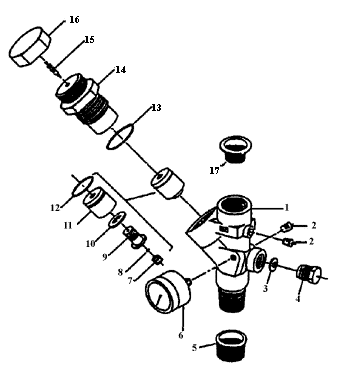
DIMENSIONS AND CONNECTION DATE:

DESIGN DATE:
- Gas: Halon 1301 + Nitrogen
- Working pressure: 25 bar at 21ºC, in a 360 psi Halon 1301 system, when the tanks are filled at a maximum rate of 1,13 kg/L
- Design temperature: -20ºC to +55ºC (-40ºC to +65ºC for shipment only- non pressurized)
-Actuation force an valve care :
theoretical minimum = 30 N
Recommended minimum =60 N
- Safety relief device : 54 +/- 3 bar
- Pressure drop : 4 m equivalent length of 3/4" pipe schedule 40
SHIPPING DATE:
|
W 28,8 : part No |
:302934 (packed in carton box) |
|
dimensions |
:height 85 - width 90 - length 140 |
|
shipping weight |
:1,4 kg |
|
1" NGT : part No |
:302936 |
|
dimensions |
:height 85- width.90 - length 140 |
|
shipping weight |
:1,5 kg |
WORMALD INTERNATIONAL
MULTIPLE STACK ACTUATOR
|
SA. ANSUL N.V. |
|
|
|
PART OF INTERNATIONAL GROUP |
MULTIPLE STACK ACTUATOR |
MFG DATA SHEET: T49 DATE:10/86 RE: |
SCOPE:
The multiple stack actuator is a very compact actuator to be mounted on the MA Valves or 1" and 2" Halon valves.
This multiple stack actuator differs from the multiple actuator in this way
that the EVA electric actuator can be mounted (or stacked) on the top.
It can
be operated pneumatically or manually whether accessories are added.
These
accessories are the same as for the multiple actuator and are described in data
sheet T48.
A lock pin which look like a big hairpin, is provided to insert during erection, inspection and maintenance, to avoid a spurious activation.
A breakseal for the actuation lever is also provided.
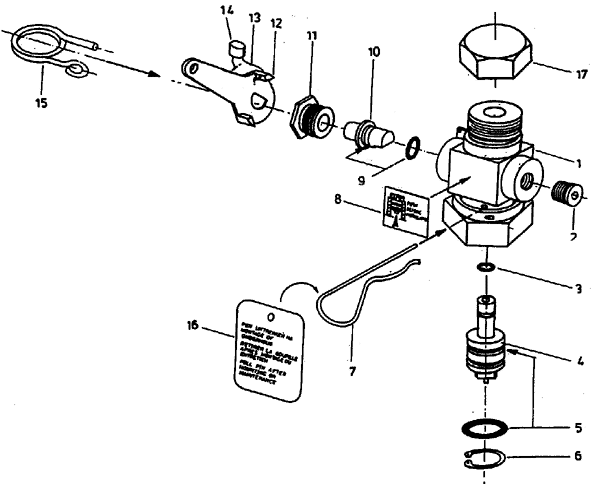
|
Fig No |
Part No |
Description - material |
|
- |
303444 |
Multiple stack actuator- packed |
|
1 |
- |
Body assembly - brass |
|
2 |
303248 |
Plug 1/4 NPT - brass |
|
3 |
800050 |
O-ring ID 6.07 Th. 1.78 mm - Buna-N |
|
4 |
303449 |
Piston - brass |
|
5 |
801098 |
O-ring ID 15.55 mm Th 2.62 mm - Buna-N |
|
6 |
801099- |
Circlip ID 21 mm |
|
7 |
302883 |
Lock pin - stainless steel 302 |
|
8 |
302769 |
Warning label - adhesive vinyl |
|
9 |
800797 |
O-ring ID 8.9 mm Th 1.9 mm - Buna-N |
|
10 |
302893 |
Axle- brass |
|
11 |
302894 |
Guide- brass |
|
12 |
303010 |
Lever- brass |
|
13 |
900631 |
Seal wire-plastic |
|
14 |
300741 |
Seal clip - iron (white enamelled - Ansul logo) |
|
15 |
303011 |
Safety pin - stainless steel |
|
16 |
303224 |
Warning label - vinyl |
|
17 |
302887 |
Cap - brass |
DIMENSIONS AND CONNECTION DATA
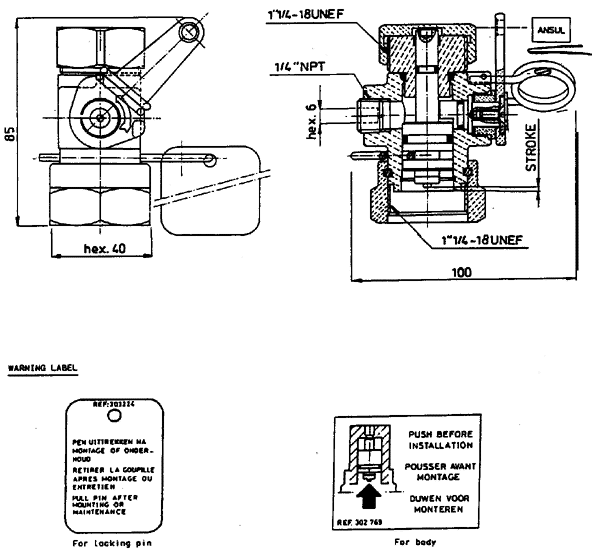
DESIGN DATA
|
Actuation pressure |
Force on lever | |||||||
|
ANSUL valves on |
Minimum |
Recommended |
Min |
Rec | ||||
|
Halon 360 psig tank at 50º and filled with 1.1 kg/l |
1 bar (15 psig) |
2 bar (30psig) |
7.5M |
15 N | ||||
|
Halon 600 psig tank at 50º and filled with 1.13 kg/l |
2.75 bar (25 psig) |
2.75 bar (40 psig) |
13 N |
20N | ||||
|
CO2 cylinder at 50º and filled with 0.75 kg/l |
3.5 bar (55 psig) |
4.5 bar (70 psig) |
26N |
35N | ||||
SHIPPING DATA
Multiple stack actuator:
part No. 303444
box dimensions 95 x 90 x 70 mm
weight: approx. 700
g
WORMALD INTERNATIONAL
MK I, II, III, IV, V AND
HIGH FLOW
HALON 1301 CONTAINERS
MK I & II PARTS EXPLOSION
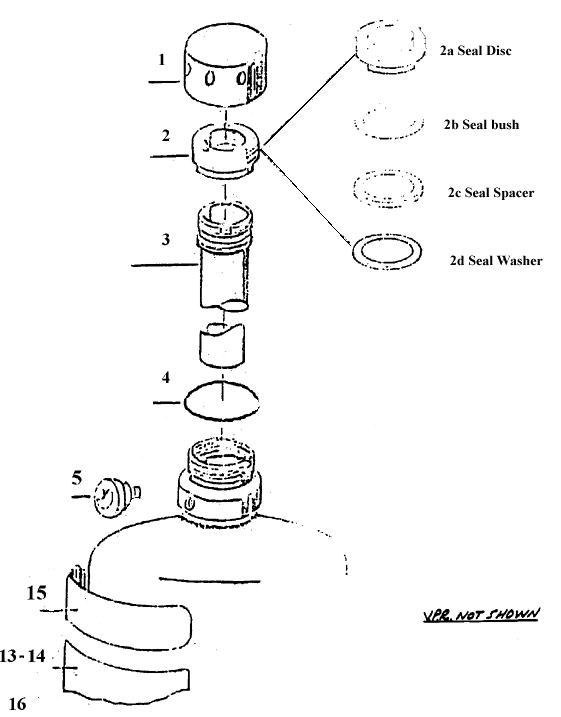
MK III PARTS EXPLOSION
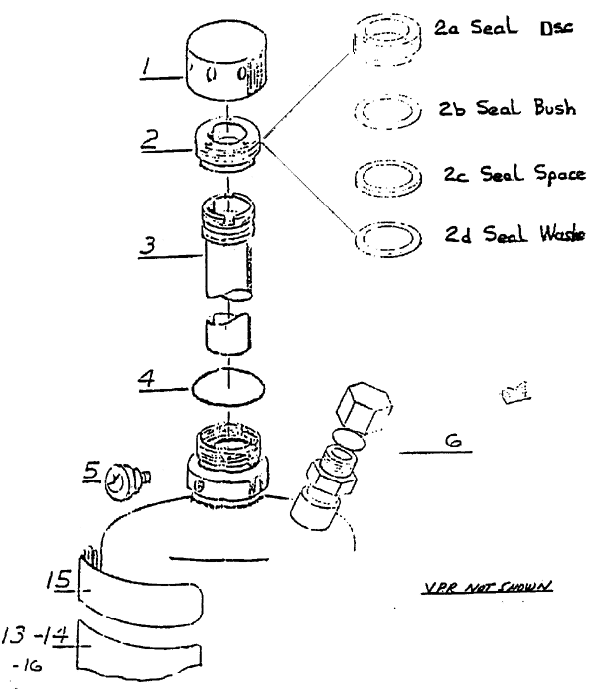
MK IV PARTS EXPLOSION
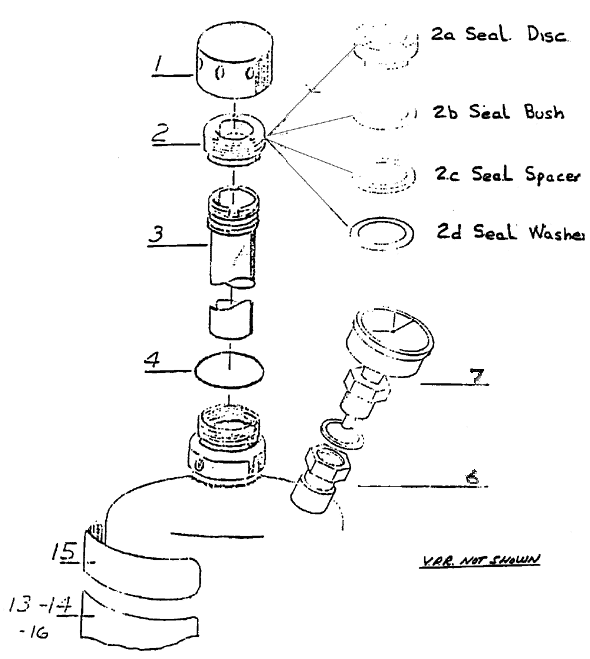


VALVE AND CYLINDER ASSEMBLIES
The Wormald cylinder and valve assemblies provide the agent, cylinder and valve assembly for both Halon 1301 and 1211 total flooding fire suppression systems They may be used singly or manifolded together to provide the required quantity of agent.
HIGHFLOW VALVES
Wormald Highflow Halon Valves are supplied as an integral part of the Halon cylinder assembly. The 25mm valve is used on the 25 and 48kg capacity cylinders and has a 25mm male NPT threaded pipe outlet. The 50mm valve is used on the 65 and 106kg capacity cylinders and has a 50mm male NPT threaded pipe outlet. The 25mm and 50mm highflow valves am of the differential pressure piston type. They are attached to the cylinder with a 2½- 12UN-2B thread with an O-Ring seal. Valve components are brass, making the valve inherently corrosion resistant. The outlet port and actuation connections are readily accessible for ease of installation and servicing. The valve assembly includes a safety relief device, a pressure gauge, connections for various ancillary equipment and transport caps. A syphon tube is permanently fitted to the valve.
The following actuators are suitable for use with the Highflow Halon Valves and fit to a threaded 1¼" - 18 UNEF-2B connection:
Refer to separate actuators data sheet for details.
The fire extinguishing agents used are Halon 1301 and Halon 1211. Both are colourless, odourless, non conductive gases. Halon is stored in the cylinders as a liquid under nitrogen superpressure, at 2500 kPa. Cylinders can be part filled with the required Halon quantity.
OPERATION
Once a tank has been filled and pressurized. The valve is sealed by means of nitrogen overpressure introduced into Chamber B. This pressure propels the piston into the valve closed position and the pressure acting on the greater surface area of Chamber B than Chamber A produces a positive sealing force. A small bleed hole C through the piston ensures that the seal is maintained by equal pressure above and below the piston.
The valve is opened by venting the pressure from the upper chamber through the vent valve D. During this venting, a rubber ball in the bleed hole checks the gas flow from A to B and the tank pressure propels the piston into its upper position. Allowing maximum free passage to the flow.
DESIGN DATA
CYLINDERS
Wormald Highflow Halon cylinders are available in 25, 48, 65 and 106 kg capacities. They are of welded steel construction, and are designed, tested and inspected in accordance with Australian standard AS2470. Every cylinder is hydrostatically pressure tested to 6900 kPa, and carries a stamped plate with all cylinder details. Standard finish is yellow enamel # 356 to BS381C, however, zincsprayed and pointed, or galvanised finishes are available to order. Cylinders a complete with fitting handles and base skirt.
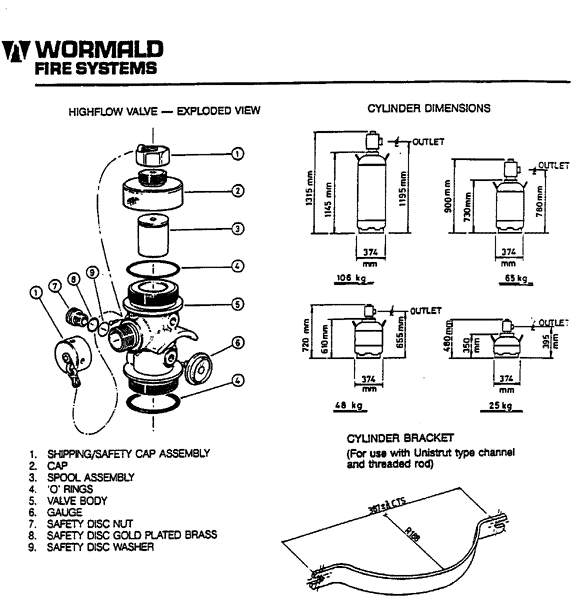
|
NOMINAL CAPACITY | |||||
|
CYLINDER SPECIFICATIONS |
25kg |
48kg |
65kg |
106KG | |
|
HALON 1301 CAPACITY WITH 1.065kg/L |
26.6 |
51.1 |
69.2 |
112.9 | |
|
HALON 1211 CAPACITY WITH 1.3kg/L |
31 |
62 |
85 |
138 | |
|
WATER CAPACITY (NOMINAL) (kg) |
25 |
48 |
65 |
106 | |
|
TEST PRESSURE (kPa) |
6900 |
6900 |
6900 |
6900 | |
|
SUPERPRESSURE (MAX) AT 21ºC (kPa) |
2500 |
2500 |
2500 |
2500 | |
|
NOMINAL TARE MASS (EMPTY) (kg) |
28 |
45 |
55 |
79 | |
|
VALVE OUTLET SIZE |
1"NPT |
1"NPT |
2"NPT |
2"NPT | |
|
WORMALD MANUFACTURING |
COMPANY PROCEDUR |
NUMBER :CP204 |
PRODUCT : HALON CYLINDERS - MKII,MK III, Mk IV, MK V HIGHFLOW
SUBJECT : RELIEVING, SUPERPESSURE & DECANTING
ORIGINAL ISSUE DATE : MAY 1987
It should be general policy to try to upgrade all Halon Systems to the Ansul - style Highflow type where possible. The major selling point here is that the removal, emptying, testing, refilling and reinstatement of the old cylinders is a major operation, which will have to be repeated every five (5) years subsequent to the initial ten (10) year inspection, in accordance with AS2030 - 1985 requirements.
MkII - MkIV valves and cylinders particularly should be replaced and their design and technology is approaching obsolescence. Mk I cylinders will NOT be refilled.
There are two ( 2) methods of decanting the range of Wormald Halon cylinders. The method used -depends on the type of container the Halon is being emptied into, the equipment available, and the efficiency required of the transfer.
METHOD 1:
BANNED
METHOD 2:
The cylinder can be emptied without first relieving the Nitrogen superpressure. Depending on the cylinder type, it may have to be inverted to allow the superpressure to force the liquid Halon out.
This method may be used when the Halon receiving vessels are only on limited volume, and-the extra pressure in the cylinder being emptie ensures maximum Halon transfer. This method tends to transfer a higher percentage of the Halon than Method 1.
METHOD 2:
2.1 CYLINDER DECANTING WHILST SUPERPRESSURISED
With this method, the nitrogen superpressure is not bled of f prior to decanting the liquid Hallon.
2.1.1 MKII Cylinders
(a) Install the filling bonnet (as supplied by Wormald Manufacturing) onto the top of the cylinder, ensuring, it is fully screwed onto the neck ring, and the valve closed.
(b) Place cylinder into a clamping device.
(C) Connect draining hoses to bonnet outlet valve, and to-the receiving vessel.
(d) Using a socket wrench or spanner assembly in the filling bonnet, turn anti-clockwise to release seal-disc.
(e) By opening all line valves slowly, Halon will flow from the superpressurised cylinder into the receiving vessel.
2.1.2 MKIII. MKIV, MKV Cylinders
(a) Connect special draining adaptors to the filler valve after first removing the pressure gauge assembly (MkIV and MkV) or Cap (MkIII). The built-in ball-check valve should prevent excessive leakage until draining adaptor is screwed fully home.
(b) Connect draining hoses and valve to draining adaptor and to the receiving vessel.
(c) Carefully invert cylinder, and clamp securely.
(d) By opening all line valves slowly, Halon will flow from the superpressurised cylinder into the receiving vessel.
2.1.3 Highflow Cy1inders
(a) Clamp cylinder securely.
(b) Connect filling/draining adaptors to outlet connection, ensuring valve on adaptor is closed.
(c) Valve can be actuated against this closed valve. by depressing Schrader Valve at the top of the Halon valve.
(d) Connect draining hoses to adaptor connection and receiving vessel.
(e) Open line valves and Halon will flow from sup superpressuris cylinder into receiving vessel.
After the above steps, there should be very little Halon left in cylinder.
NOTES:
(i) Where possible the easiest and most economical results are achieved when a 1/2 ton or 1 ton cylinder is used as the receiving vessel.
(ii) To assist in Halon transfer, where possible the receiving vessel should be kept cool and below the level of the cylinder being decanted.
(iii) If a brine task or chiller unit is available, the Halon should be pumped through this to further aid transfer.
(iv) Transport caps should always be fitted where possible.
(v) Always provide maximum ventilation to filling/decanting area - DO NOT SMOKE whilst performing these operations.